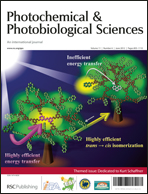We report the photophysical and electrochemical properties of phenol–pyrrolidino[60]fullerenes 1 and 2, in which the phenol hydroxyl group is ortho and para to the pyrrolidino group, respectively, as well as those of a phenyl–pyrrolidino[60]fullerene model compound, 3. For the ortho analog 1, the presence of an intramolecular hydrogen bond is supported by 1H NMR and FTIR characterization. The redox potential of the phenoxyl radical–phenol couple in this architecture is 240 mV lower than that observed in the associated para compound 2. Further, the C60 excited-state lifetime of the hydrogen-bonded compound 1 in benzonitrile is 260 ps, while the corresponding lifetime for 2 is identical to that of the model compound 3 at 1.34 ns. Addition of excess organic acid to a benzonitrile solution of 1 gives rise to a new species, 4, with an excited-state lifetime of 1.40 ns. In nonpolar aprotic solvents such as toluene, all three compounds have a C60 excited-state lifetime of ∼1 ns. These results suggest that the presence of an intramolecular H-bond in 1 poises the potential of phenoxyl radical–phenol redox couple at a value that it is thermodynamically capable of reducing the photoexcited fullerene. This is not the case for the para analog 2 nor is it the case for the protonated species 4. This work illustrates that in addition to being used as light activated electron acceptors, pyrrolidino fullerenes are also capable of acting as built-in proton-accepting units that influence the potential of an attached donor when organized in an appropriate molecular design.
![Graphical abstract: Optical and electrochemical properties of hydrogen-bonded phenol-pyrrolidino[60]fullerenes](/en/Image/Get?imageInfo.ImageType=GA&imageInfo.ImageIdentifier.ManuscriptID=C2PP05351A&imageInfo.ImageIdentifier.Year=2012)
You have access to this article
 Please wait while we load your content...
Something went wrong. Try again?
Please wait while we load your content...
Something went wrong. Try again?
![Graphical abstract: Optical and electrochemical properties of hydrogen-bonded phenol-pyrrolidino[60]fullerenes](/en/Image/Get?imageInfo.ImageType=GA&imageInfo.ImageIdentifier.ManuscriptID=C2PP05351A&imageInfo.ImageIdentifier.Year=2012)

 Please wait while we load your content...
Please wait while we load your content...